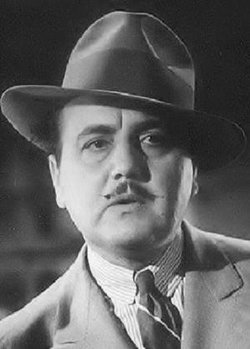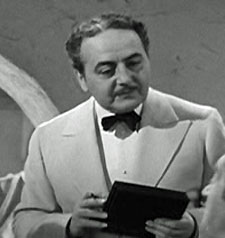By Ed Garea
Edited by Steve Herte
The purpose of this
column is to bring recognition to actors whom we’ve seen many times in the
movies or on television over the years and whose name is always on the tips of
our tongues. We no sooner recall it to mind than we forget it once again and it
becomes a question passed around amongst movie buffs.
In this column, we are
spotlighting an actor many people remember seeing at one time or another and
yet whose name we can never quite recall for any length of time. It seems that
as soon as we forget it, there he is once again in a movie or television show
and the entire process starts over again to our eternal frustration.
In the case of Gino Corrado, it is entirely understandable,
for this durable actor has – get this – appeared in 391 titles. No, I’m not
making this up – 391 titles to his credit.
Granted, out of those
391 titles in which he appeared he is unbilled in all except for about 100. But
still, this is an impressive number and a testament to the perseverance of
hanging around at casting calls and getting steady work.
He was born Gino Corrado Liserani in
Florence, Italy, on February 9, 1893. He attended the College of Strada in
Italy, finishing his education at St. Bede College in Peru, Illinois. It’s not
known if he accompanied his family to America or came on his own, but his first
credited film is a 1916 short titled The Last Challenge. He played
a boxing referee and was billed under the name “Eugene Corri.”
His next film was an uncredited
appearance as “The Runner” in D.W. Griffith’s lengthy masterpiece, Intolerance.
After this, for the next few years he received billing in various silent films,
always under the name “Eugene Corey,” an Americanization of his last name.
Finally, in 1923, he was
billed fifth under the name Gino Corrado in Sam Wood’s comedy, produced by Famous
Players-Lasky, My American Wife, starring Gloria Swanson. Work –
and billing – appeared quite steady in the silent ‘20s, but when the Sound Era
hit Hollywood to stay, his credited billing suddenly dried up, as did the size
of his roles. He appeared in many films, but the roles were smaller, almost
walk-on appearances, and it was a rare day indeed when he was billed in the
cast. Many of the uncredited roles he played were as chefs or waiters, which
was ironic, because when he wasn’t working in films he earned a steady paycheck
working as a real waiter.
Corrado holds a
distinction of sorts, as he is the only actor to appear in Gone with
the Wind, Citizen Kane, and Casablanca. He also
made appearances in Mr. Smith Goes to Washington, The Great
Dictator, and The Grapes of Wrath.
Rare were the occasions
when his role lasted beyond two lines. He did well playing a rurales captain in
the John Wayne low-budget Monogram oater, Paradise Canyon in
1935. Here he received fifth billing. Oft times, though, he was paid more for
his unbilled roles with major studios than he earned with billing in the
Poverty Row films.
In 1936 he had a small
role – and 13th billing – as Forrenza in The Oregon
Trail, a John Wayne Western for Republic. He was given billing in two other
Westerns made shortly after, one of which, Rebellion (1936)
co-starred a young Rita Cansino, who later achieved superstardom as Rita
Hayworth.
His last credited
appearance came in 1946 in the Columbia short Honeymoon Blues,
starring Hugh Herbert and Christine McIntyre. Corrado played Bruno the
Swordsman. He also made a mark in several Columbia shorts starring The
Three Stooges. His best performance was in Micro-Phonies (1945)
as a pompous violinist/singer with whom The Stooges have several run-ins. The
highlight of the short is when Moe, Larry and Curley become annoyed and shoot
cherries into his mouth as he sings an aria.
His last appearance was
as a shoe salesman in the 1954 Dean Martin-Jerry Lewis comedy, Living
It Up. After his retirement he worked as a maitre d’ at a Los Angeles
restaurant.
Corrado died at the age
of 89 on December 23, 1982, survived by wife (of over 50 years) Anna Alberti,
whom he married in 1931. He is buried at Valhalla Memorial Park Cemetery, and
his gravestone epitaph is etched with his video-screen image from Micro-Phonies, along with the
inscription, “Forever on the Screen – Forever in Our Hearts.”
Special
thanks go to reader Shelby Vick, who suggested Gino Corrado for this column.




No comments:
Post a Comment